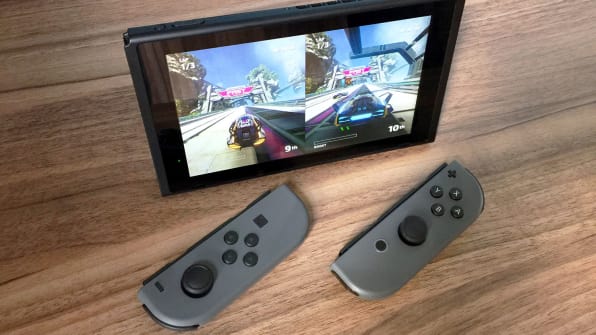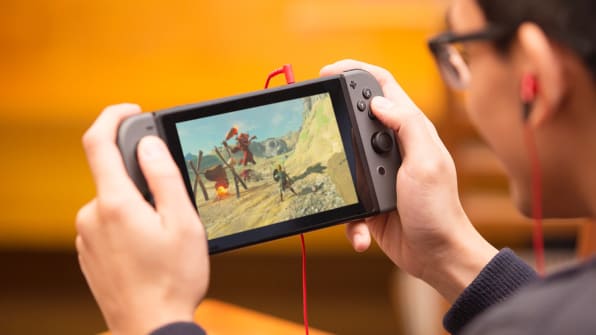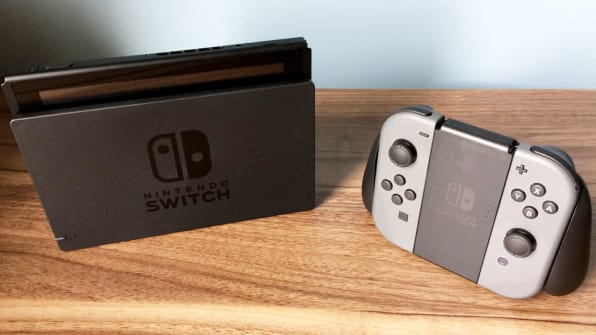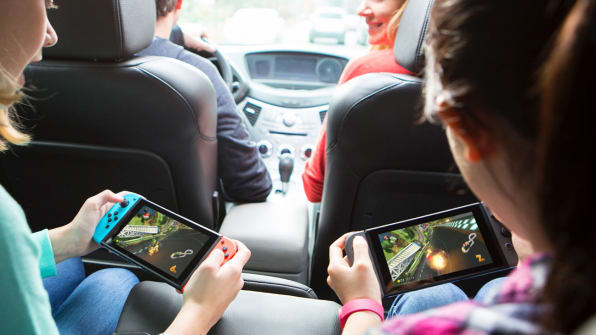Nintendo Switch Review: Past And Future In Equal Measure
I’ve been agonizing over what to say about my time with the Nintendo Switch since the first reviews went up.
On one hand, the hardware is a marvel of modern mobile architecture, running console-grade games for hours on a battery charge. Press the power button, and the 6.2-inch display lights up almost as quickly as a smartphone would, ready to jump right back to The Legend of Zelda: Breath of the Wild or whatever else you’d been playing with no loading screens. Being able to drop the Switch into a TV dock for big-screen play is just icing.
On the other hand, Nintendo’s vision for ambitious online services is a no-show. Over the past couple of years, the company has spoken of loyalty programs, deep ties between its console and smartphone games, and a cloud back-end for syncing saved games and other data. None of those things exist in the product that Nintendo is launching right now.
The result is the first game console whose hardware feels like a credible counterattack on smartphone gaming, but whose services feel anchored to the past. Also, the Switch has one potentially disastrous defect.

In With A Snap
The Nintendo Switch draws its name from the modular nature of the system, which includes a 6.2-inch tablet (with a kickstand on the back), a pair of attachable “Joy-Con” controllers, a grip accessory for holding the Joy-Cons together like a regular game controller, and an HDMI dock that sends audio and video from the tablet to a TV.
Within this system, a few modes of play emerge:
- By yourself on the tablet, with controllers attached or held separately in each hand.
- By yourself on the TV, with controllers held separately or connected to the grip accessory.
- With a friend on the tablet or TV, separating the two Joy-Cons into mini-controllers for each player.
The modular approach could easily come off as complex, but Nintendo handles it with elegance. A small release button on each Joy-Con allows them to slide free from the tablet or controller grip, and a controller menu appears on-screen any time the connections change. Transitioning between portable and TV modes is as simple as plopping the tablet into the dock and yanking it back out again: The video pops up on either screen a second or two later.
Beyond Nintendo’s obvious 2-in-1 sales pitch, the Switch solves some other genuine problems. Offering two detachable controllers in one portable package lowers the barriers to competing with a nearby friend, which has become a sadly lost art in modern gaming. And by combining home and portable hardware into one unit, Nintendo no longer has to fracture its game development efforts between radically different platforms. (Nintendo has said it will keep releasing new games for its existing 3DS portable until at least next year, but Switch seems likely to take over in the long run.)
I must mention, however, a major problem with my Switch review unit: While docked, the Switch would intermittently lose its connection to the left Joy-Con, often for several seconds at a time. This occurred frequently enough to make games unplayable on the television. Numerous other reviewers have experienced the same problem. A Nintendo support page points to numerous potential causes, the most likely culprit being wireless interference, yet this has not been an issue for any of the numerous other consoles in my entertainment center (or the right Joy-Con, for that matter). Nintendo says it’s looking into the problem further.

Little Guy, Big World
As with any console launch, the first batch of games is not only designed to entertain, but to prove the system’s potential. And Nintendo has a whopper in The Legend of Zelda: Breath of the Wild.
Zelda puts you in an open world whose vastness reveals itself any time protagonist Link reaches the top of a tower or mountain. Spot a glowing shrine along a sun-drenched valley in the distance, and Link can almost certainly get there by foot, hang glider, or horseback. Infiltrate the belly of the giant mechanical elephant, and you might gape at how small Link seems within the beast’s inner workings.
The game’s scale might not be so impressive if it wasn’t happening on a device the size of a small tablet, which runs quietly, doesn’t get uncomfortably warm, and manages roughly a few hours of play time on a battery charge. The Switch, which uses an Nvidia Tegra X1 processor, is a testament to the ascent of ARM’s chip architecture, which powers pretty much every phone and tablet on the market.
Nintendo’s bet on ARM could prove wise in the long run, as the technology becomes increasingly powerful without losing its portability. That could help give Nintendo an edge in portable virtual reality headsets, which the company says it’s exploring. Still, the approach does pose some short-term challenges. The list of upcoming Switch games reveals few big-budget releases from major publishers, and the launch lineup offers nothing to demonstrate how the Switch holds up against Microsoft’s Xbox One and Sony’s PlayStation 4, which use the same x86 architecture as PCs. Porting games from those consoles to the Switch may be a tough engineering challenge.
It helps, then, that Nintendo is pursuing a separate strategy of wooing independent developers, whose creations tend to be less demanding. Shovel Knight: Specter of Torment, for instance, is an excellent homage to 8-bit platform games, and Fast RMX is a futuristic racer that allows split-screen multiplayer with the Switch’s two Joy-Con controllers. In lieu of broad support from mega-publishers, these games could help carry players over between Nintendo’s own tentpole releases.

Head In The Sand
For most of my time with the Nintendo Switch, Nintendo’s online system wasn’t yet available. But even after Nintendo enabled it with a launch-day patch, not much has changed.
The eShop is now open for purchasing downloadable games, but only a handful are available, and the Virtual Console store for classic Nintendo games isn’t online yet. The My Nintendo Rewards program, which offers discounts on game content in exchange for buying and playing other games, is not yet active on Switch either. And Nintendo has not said whether it will support cloud saves, which would be useful for syncing progress between multiple Switches in a home.
Meanwhile, the only link I’ve found to Nintendo’s budding smartphone ecosystem is the ability to add fellow Super Mario Run players to my friends list. (Aside from that method, or adding other Switch owners who are nearby, the only way to build your friends list is by sharing randomly assigned 12-digit codes.) The StreetPass and Miiverse social features of Nintendo’s 3DS console aren’t making their way over to Switch either. And while other consoles have delved into the phenomenon of live game streams and YouTube videos, the Switch only supports capturing and sharing screenshots for now.
The problem isn’t so much the individual missing elements, but the overall sense that Switch isn’t really a connected device. Sure, you can download games and play with other people over the internet, but there’s little broader connectivity to the world of phones, tablets, and PCs, let alone other Nintendo hardware. (It’s sort of astounding, by the way, that the popular NES Classic Edition has no tie-ins to the Virtual Console on other Nintendo devices.)
Nintendo often draws comparisons to Apple for its integration of hardware and software, but even Apple realizes hardware and software are not enough anymore. Online services are now just as important, yet Nintendo seems to have missed the memo despite its repeated claims to the contrary.

Into The Future
The upside is that Nintendo can still develop those online services, at least in theory. While we’re speculating, the company could also bank on improvements in ARM for future iterations of Switch, and start closing the performance gap with its console rivals. Satoru Iwata, Nintendo’s former president and CEO who died in 2015, had even hinted at a suite of devices all running on the same platform, akin to Apple’s iOS.
Those possibilities make it difficult to surmise whether the Nintendo Switch is a success. The device isn’t merely unfinished in terms of game selection and features, as all new consoles tend to be. It’s a blank slate upon which Nintendo is expected to build its future, and we still don’t know what that’s going to look like. Here’s what I know for certain: The Switch is Nintendo’s most interesting new device since the Wii, and its most important since the original NES arrived over 30 years ago.
Fast Company , Read Full Story
(52)














